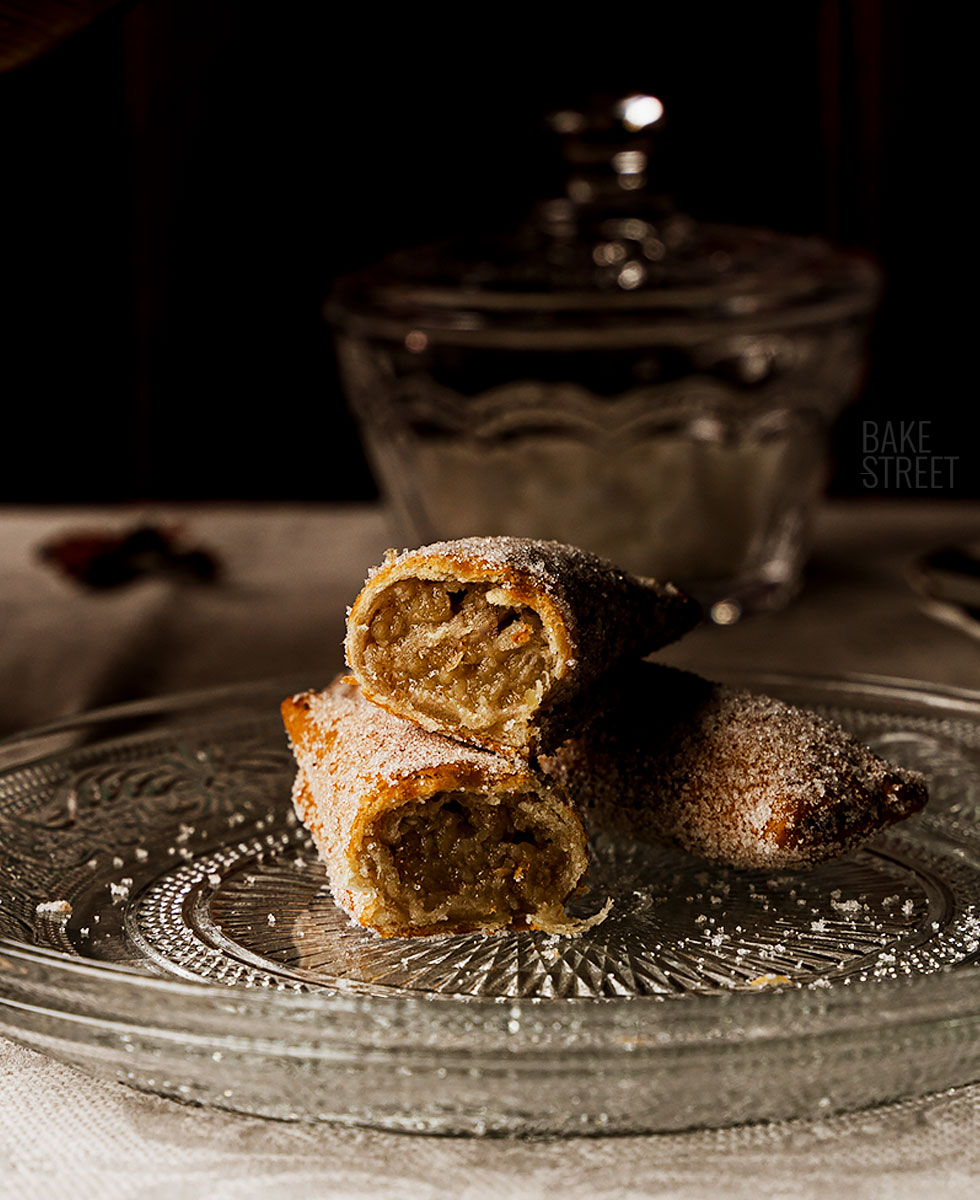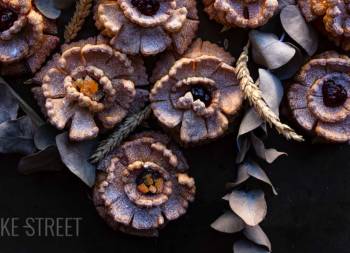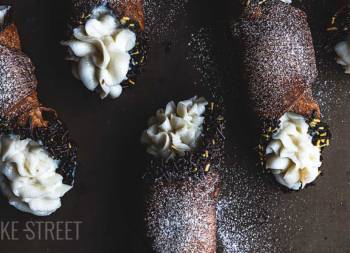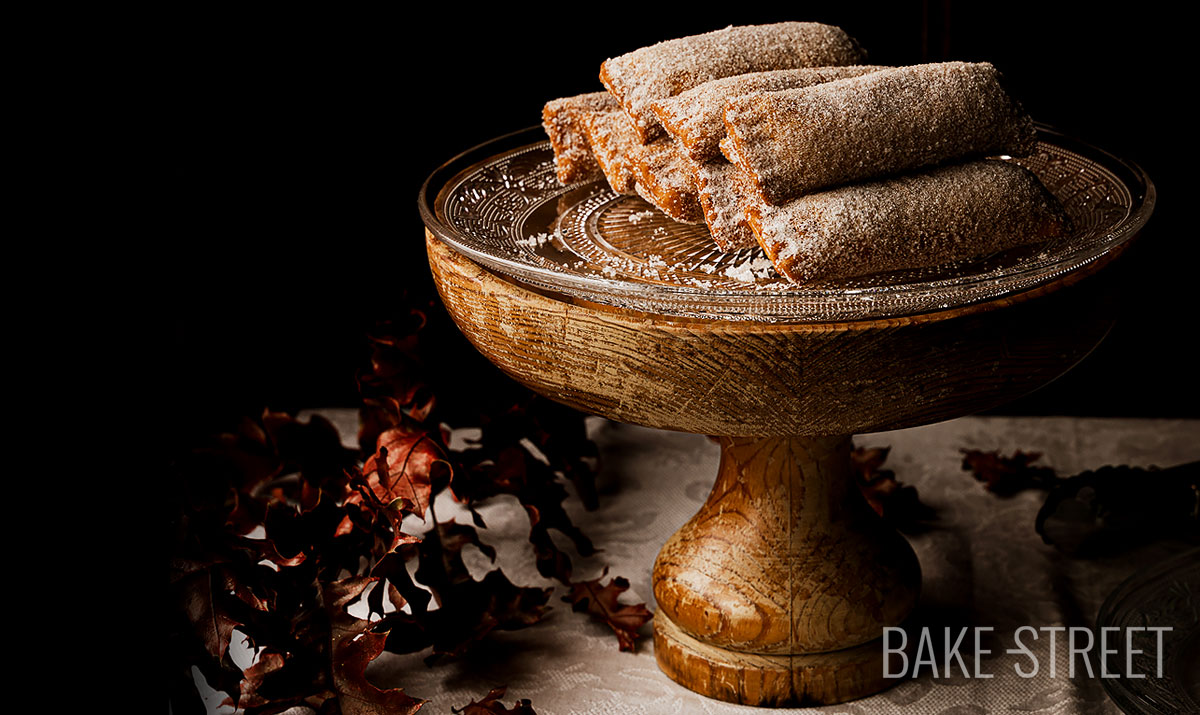
Casadielles, traditional pastry from Asturias
Lately I’ve been very “Asturian”… Today I bring you a wonderful Carnival recipe, Casadielles, traditional Asturian pastry (which, I assure you, you will be amazed if you haven’t tried them), and a few days ago I left you the recipe for Fabes con almejas. I have to say that it was pure coincidence that both recipes coincide in the same week. This year I was looking forward to making casadiella or frisuelos for this time of year and I had already planned faba recipe.
Between the two recipes, I finally decided to go for these thanks to the fascinating walnut filling. It called out to me with shouts and exclamations. It was certainly the whole thing that attracted me. A fried dough, made with white wine and filled with walnuts and aniseed liqueur… There wasn’t much to think about if I’m honest.
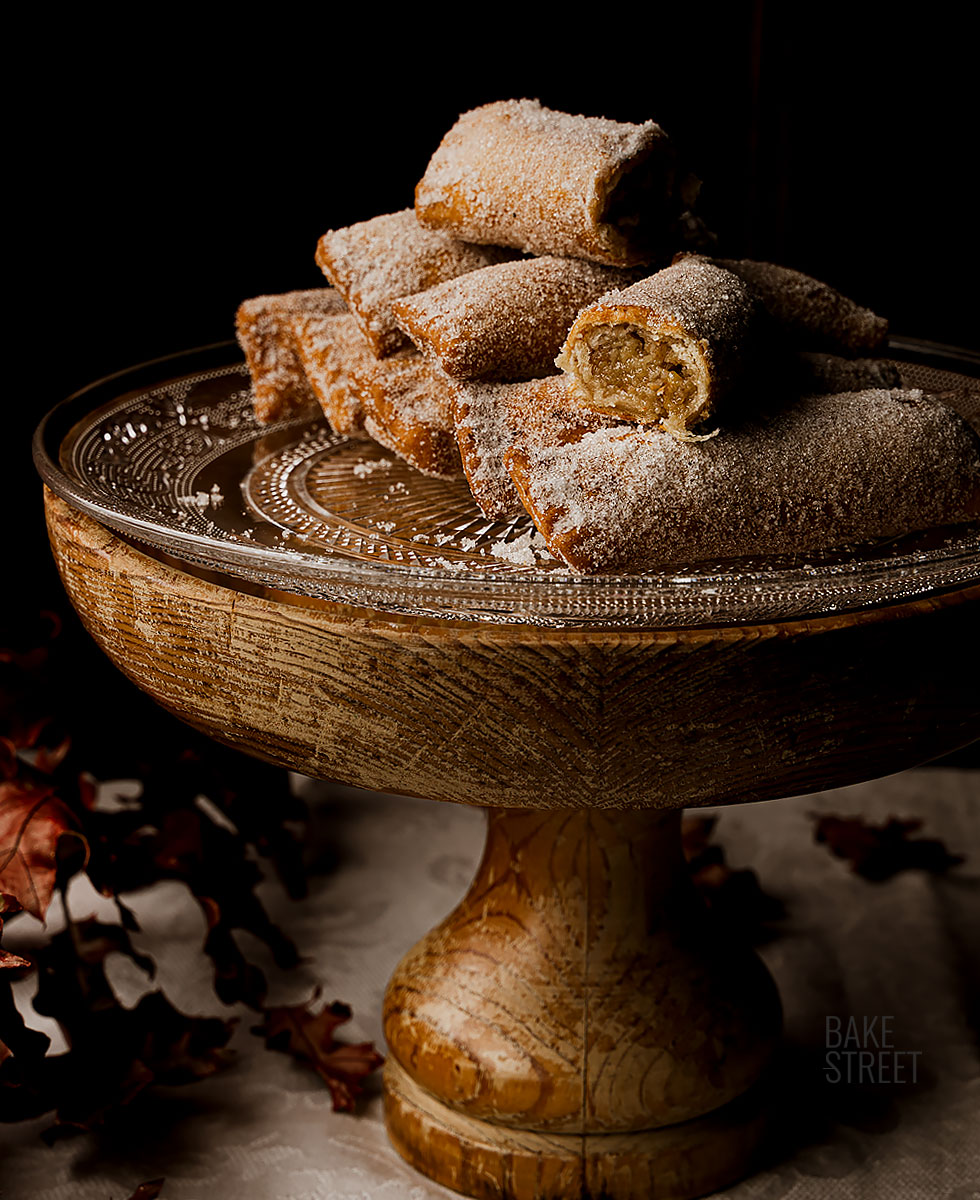
Casadiella, in plural and in Asturian, casadielles.
This is one of the most typical and traditional desserts in Asturias, along with frisuelos(I have to make these and will do so soon). They are traditionally eaten at Christmas, Carnival (antroxu) and Easter. Apparently it is said that they are halfway between empanadillas(pasties) and the so-called “frutas de sartén” (pan fruits).
Is there anything more wonderful than the name, frutas de sartén – pan fruit? I think it is absolutely superb.
This term is used to describe culinary preparations that are fried, i.e. cooked in hot oil. The technique of frying dough dates back to medieval times in Spanish cuisine, a practice known from Sephardic cooking.
Some of the earliest Spanish cookbooks describe this frying process by this name. I really think it is beautiful.
In the Llibre de Sent Sovíof 1324, there is a recipe for ffrexols and bunyols de fformatge d’ous. A century later, the cook Ruperto de Nola, in his book “Libro de manjares, guisados y potajes” (Llibre del Coch) of 1477, describes the light frying of poultry liver as a fruit.
Most recipes include the preparation of a dough or batter which may contain grated cheese and egg. The fruitis described as a flour batter to which eggs and sugar are usually added. It is then fried in vegetable oil, butter or lard, and in some recipes the fried dough is usually sweetened with honey.

Returning to the casedielles, if there is anything interesting about them, it is where they get their name from.
Eduardo Méndez Riestra says in his book “Cocinar en Asturias” (Cooking in Asturias) that it is possible that it comes from a deformation of “cosadielles” (riddles – “what little thing is…?”), since the surprise is to be found in the filling.
There are two options for making them: puff pastry or a dough made with flour, white wine, butter… The recipe I bring you today. The size is somewhat larger than the one I have left you, it is said that the weight should be around 70-80 g and have a length of approximately 15 cm. When it comes to making them, the traditional method is to fry them. Nowadays, however, you can also find recipes for baking them in the oven.
We will prepare them in the traditional way, fried in olive oil flavoured with citrus fruit and cinnamon. If we work the dough well and fry at the right temperature, the casedielles will not be oily at all. Neither to the touch nor to the taste. They will be crispy and incredibly delicious.
Casadielles recipe
Ingredients for 15-16 pieces
Recipe adapted from La cucharina Mágica
DOUGH:
- 400 g cake/pastry flour
- 150 g white wine
- 50 g mild olive oil 0,4º
- 50 g unsalted butter, melted and cooled
- 30 g lard
- 1 large egg yolk
- 8 g baking powder
- 7 g salt
FILLING:
- 200 g walnuts, peeled
- 85 g sugar
- 40 g sweet anise liqueur
- 25-30 g water
FOR DECORATING:
- sugar (in my case I use sugar flavoured with vanilla pods)
FOR FRYING:
- 600-650 g mild olive oil 0,4º
- one orange peel
- one lemon peel
- 1 cinnamon stick
MATERIAL WE WILL NEED:
- bowls
- rolling pin
- pan
- scraper
- digital kitchen thermometer
- fork
- mortar or food processor
Instructions
Flavour the oil.
- In a saucepan, add the olive oil and place over medium-low heat.
- Once it is warm, add the orange and lemon peel (previously washed and dried) together with the cinnamon stick.
- Simmer for 3-4 minutes.
- Turn off, remove from the heat and leave to rest.
Prepare walnuts filling.
- Use a mortar and pestle to crush the walnuts. Do not grind them too much or too finely, as you run the risk of obtaining a greasy paste.
- Transfer the crushed walnuts to a bowl and add the sugar and anise liqueur. Mix together.
- Pour the water, little by little and mixing each time. In this way we can control the final consistency of the mixture, so that it is not too soft or watery.
- Cover with cling film and leave to stand until ready to use.
Prepare the dough for les casadielles.
- In a bowl, add the white wine, olive oil and salt. Mix with a whisk until emulsified.
- Add the baking powder together with the melted and cooled butter, egg yolk and lard. Whisk until a homogeneous mixture is obtained.
- Pour this mixture into a larger bowl and begin to add the flour little by little. Add a small amount and mix with the help of a spatula.
- Continue adding while mixing.
Once all the flour has been incorporated, mix with the help of your hands. - Transfer to a clean work surface and knead until the dough is smooth and homogeneous.
- Make a ball, cover with a bowl and leave to rest for 1 hour.
Fold the dough and make a second rest.
- Roll out the dough and make a simple fold.
- Roll out the dough again and fold. In total we make 3 single folds.
- Cover again with the bowl and leave to rest for another hour.
Shape les casadielles.
- Divide the dough into two equal portions, making it much easier to work with. Cover the dough that you are not going to work with with cling film and set aside.
- Roll out the dough on a clean surface until the dough measures approximately 24 x 40 cm.
- With the help of a scraper, cut off the edges for a cleaner finish.
- Divide the dough in half and proceed to shape them.
- Place a little filling, take an amount similar to the size of a walnut, and put it on the dough. Shape the dough into an elongated shape.
- Fold the dough over the filling, moisten with water and turn the piece so that it is wrapped in the dough.
- Cut with the help of a scraper to separate the piece.
- Seal the ends well and press with a fork.
- Repeat the same process with the rest of the pieces.

Fry.
- Remove the citrus peel and cinnamon stick from the oil. You will notice that it has acquired a slightly cloudy colour, but that's fine.
- Place over medium-high heat and allow it to reach a temperature of 355ºF/180ºC. Once hot, the oil will regain its "crystalline" appearance.
- Place a casadiella in the oil, with the sealed side or the joint facing downwards (this helps it to seal more quickly and prevents it from opening). If we wish, we can hold the casadiella with a slooted spoon or two forks so that it is submerged under the oil (and the joint, as it is stuck to the base of the pan, does not open). This step ensures that the sealing does not suffer, swell and, consequently, open up and all the stuffing comes out.
- Fry until it acquires a nice golden colour.
- Remove from the pan, place on absorbent paper for 5-10 seconds and then coat in sugar. The sugar will only stick to the casadiella if it is hot.
- Place on a tray and fry the rest of the pieces.
- Serve.

Notes
- To make the dough we have to use a loose (low protein) wheat flour, that is to say, the variety of flour we use to make sponge cakes or biscuits. Pastry or cake flour.
- I recommend not omitting the lard. This type of fat makes the dough incredibly soft, as well as giving it a very traditional and pleasant flavour.
- If you do not want to use lard, butter or olive oil can be used instead.
- Emulsifying is a technique that consists of mixing two liquid and immiscible components with a substance that serves as a vehicle and another that is in suspension. It can be done physically, by means of energetic but unstable movements, or chemically, with emulsifiers such as, for example, egg yolk.
- I have made the filling with walnuts, as is the case with many other recipes. But it can also be made with a mixture of walnuts and hazelnuts or walnuts and almonds. If you wish, you can use another nut instead of walnuts.
- The filling has an intense aniseed flavour; if you wish, you can reduce the quantity used a little and replace it with water. If you don't like anise liqueur, you can omit it and use another liqueur... But it will have nothing to do with the final result of this pastry.
- At home, I always flavour the sugar with the vanilla pods I use. It gives a wonderful aroma and greatly enhances the preparations we make with it. It is as easy as storing the vanilla pods in the same container as the sugar.
- I use 0.4º mild olive oil for frying, but you can substitute it with sunflower oil if you prefer.
- Flavouring the oil will add a wonderful extra flavour to the casadielles.
- Remember to fry always dipping the sealed side down first. Hold casadielles to prevent them from cracking open.
- The oil must be hot, but never smoking, so that the cooking process is correct and the casadielles are not greasy. I recommend using a digital cooking thermometer.
- Do not transfer casadielles directly from the frying pan to the sugar because oil residues from the slotted spoon will fall in and make them lumpy. Ideally, leave it for a few seconds on absorbent paper and then coat it in sugar while it is still hot. Be careful not to burn your fingertips, in my case I think I already have a callus...
- They can be kept in an airtight container at room temperature for 4-5 days.

You've probably already thought about the sweet treats you're going to prepare during these carnival days, but I recommend you try this recipe for Casadielles because it's something out of this world.... It really is.
In general, I really like this type of pastries, the traditional ones, which are made with a fried dough and can be flavoured or spiced, and which is also filled. Every bite is like going back to childhood. In my case, not because I ate these pastries when I was little (in fact, it's the first time I've tried them!). But this type of elaboration reminds me a lot of pestiñosthat my mother makes every Christmas and, inevitably, they take me back to that time in my life.
I hope you have a great weekend!
Lots of love,
Eva
Sources: Postres Originales


